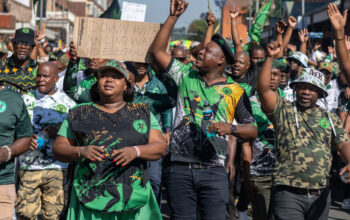
ORIKHIV, Ukraine — Squeezed between the Ukrainian and Russian front lines in an increasingly volatile battlefield in southeastern Ukraine, the small town of Orikhiv is constantly under fire, and Tamara Mikheenko, one of the few residents who remain, rarely leaves her basement.
Struggling to communicate though tremendous sobs on Tuesday, Ms. Mikheenko, 70, begged world leaders, including the presidents of the United States, Russia and Ukraine, to do whatever necessary to stop the savagery, even as Russian forces appear to be preparing a large offensive that officials say could steamroll Orikhiv in the coming days.
The night before, an explosion ripped into the unoccupied home of the neighboring house, violently jolting the dark cellar Ms. Mikheenko was hiding in.
“All the time in the basements, at night, under fire,” she said through sobs as yet another explosion thumped outside. “The blast wave injured me on one side. It’s very scary, like a lightning bolt, everything is falling apart, the house is falling apart.”
Orikhiv lies among a small constellation of tidy farming villages standing right in the path of Russian troops advancing from the south and east. Ukrainian officials believe Russian forces are preparing to make a major push forward in an attempt to expand a stretch of southern Ukrainian territory they seized in the opening days of the war.
Shelling along this front has intensified in recent days and all over the region Ukrainian forces are digging new trenches and fortifying positions.
It is in and around these villages, still home to goats, cows and chickens, but to fewer and fewer people, that the current, pivotal phase of the war for Ukraine’s east is being fought. After failing to take the capital, Kyiv, and meeting as yet impenetrable resistance along Ukraine’s Black Sea coast, President Vladimir V. Putin of Russia has turned the remaining might of his army on the fertile plains east of Ukraine’s Dnipro River and a few key major cities.
Already, Russian forces have gobbled up nearly 80 percent of the Donbas region, as well as a ribbon of land connecting Russian territory to the Crimean Peninsula, which Mr. Putin annexed in 2014. One by one, the towns south and east of Orikhiv have fallen into Russian hands.
Should Orikhiv also fall, Russian forces will have nearly an open path to the large industrial metropolis of Zaporizhzhia, just under 40 miles away. Zaporizhzhia’s prewar population of about 750,000 has swelled with the daily arrival of evacuees from nearby territory now occupied by Russian forces, including the battered port city of Mariupol. Around the city, a sense of impending danger is palpable. Air raid sirens now sound several times a day and the local military hospital is filled with troops coming in from the front lines with ghastly injuries.
On Tuesday, Russia’s military launched a rocket attack against targets inside the city, narrowly missing its nuclear power plant, the largest in Europe when fully operational, according to officials. The rockets hit a city utility, killing one person, though the local government provided no further details.
Since the start of the war on Feb. 24, rocket attacks have been rare in Zaporizhzhia. Not so in Orikhiv. The town is just three miles from the Russian lines, and shelling occurs around the clock, becoming particularly intense in the evenings. Several houses were hit overnight on Tuesday, including the one belonging to Ms. Mikheenko’s neighbor, Vitaliy Kononenko.
“This is what the Russian world has brought us,” Mr. Kononenko said, inspecting the large hole punched through the front of his home. Inside, plastic ceiling panels had melted and the fur of a large teddy bear sitting in the window of a child’s room was singed. Fortunately, it was the only casualty.
Russia-Ukraine War: Key Developments
The house, which Mr. Kononenko said he had recently finished building, would have burned to the ground had Ms. Mikheenko’s son, Aleksandr, not dashed from the basement to put it out.
Orikhiv’s mayor, Kostyantin Denisov, said that, miraculously, the city has suffered no casualties despite the constant shelling. This is partly because of the decision early on to evacuate as many people as possible. Today, only about 30 percent of the city’s prewar population of 20,000 remains, he said.
Some of those still in the city, like Ms. Mikheenko, stay holed up in their basements, but not everyone. On Tuesday, among the clusters of neat single-family homes was the occasional resident fussing about in a beautiful blooming front garden.
Mr. Denisov has stayed in place, refusing to leave his office in the peach-colored City Hall building. He is needed, he said, to help with the city’s defense, which not an easy task. The 251-year-old town was once located on a number of trade routes and has at least seven roads leading into it.
“Now we have to close these routes off from our uninvited guests,” he said. “That’s our main task. We won’t surrender.”


